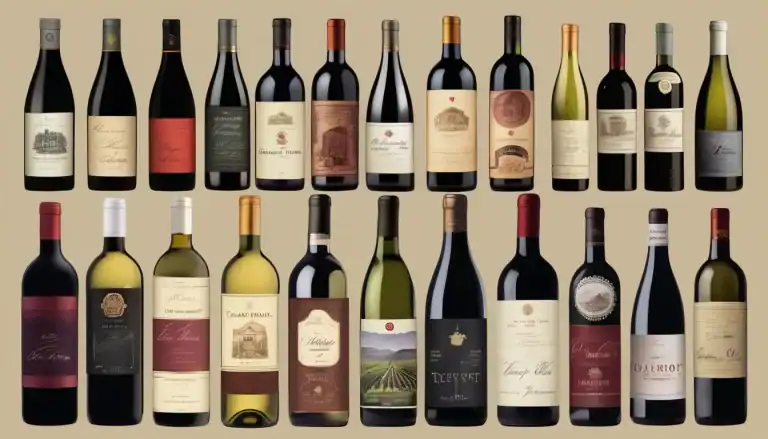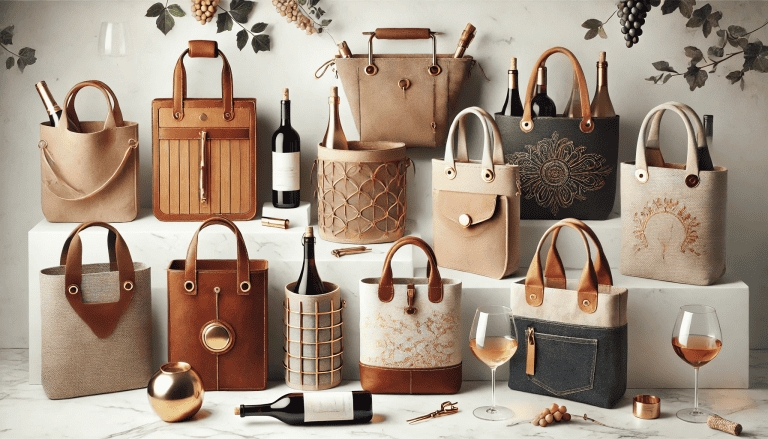Did you know improper insulation can ruin up to 25% of stored wine? Yikes! As a wine enthusiast, you know that protecting your precious collection is crucial. But here’s the thing – it’s not just about keeping your wines cool. It’s about creating the perfect environment for them to age gracefully. That’s where proper wine cellar insulation comes in.
In this guide, we’ll uncork the secrets to optimal wine cellar insulation, ensuring your vintages reach their full potential. Let’s dive in and transform your cellar into a haven for your beloved bottles!
Welcome to Didi Somm, and Cheers!
Important Notice: The information in this article is for general and public information purposes only. It solely reflects Didi Somm’s or his Staff’s opinion, and no responsibility can be assumed for errors or omissions in the service’s contents. For details, please check the Disclaimer at the bottom of the homepage.

Key Takeaways
Understanding the Importance of Wine Cellar Insulation
Let me tell you, when I first started collecting wine, I had no clue how crucial proper insulation was. Well, did I learn that lesson the hard way! Picture this: it’s mid-summer, and I’m showing off my new “wine cellar” (aka a corner of my basement) to friends. As I reach for a prized Cabernet, I notice the cork’s pushed out and there’s sticky residue on the bottle neck. Talk about a facepalm moment!
That’s when I realized that insulation isn’t just for fancy collectors – it’s for anyone who wants their wines to taste right. Insulation is like a comfy blanket for your wine bottles, keeping the temperature and humidity just right. Kinda like Goldilocks – not too hot, not too cold, but “juuust” right.
Now, let me break it down. Insulation is your best friend for maintaining consistent conditions. It’s a shield against the outside world, protecting your precious bottles from sneaky temperature swings that can mess with their flavors. Trust me, these fluctuations are the arch-nemesis of good wine!
Here’s a little secret: Good insulation can save you money in the long run. After I properly insulated my cellar, my energy bills took a nosedive. It’s like my wines and my wallet were finally on the same team!
And don’t forget the long-term benefits for wine quality and aging potential. This is where the magic happens, folks. Proper insulation is like giving your wines a time machine, allowing them to age gracefully and develop those complex flavors we all drool over.
So, take it from someone who learned the hard way – don’t skimp on insulation.
Key Factors in Choosing the Right Insulation for Your Wine Cellar
Let me tell you, picking the right insulation for your wine cellar is like choosing the perfect wine pairing – it can make or break the experience! After my fair share of cellar mishaps, I’ve learned a thing or two about what really matters.
R-value
First, let’s talk R-value. No, it’s not a fancy wine rating system – it’s your insulation’s report card. The higher the R-value, the better it keeps the heat out and the cool in. When I first heard about it, I thought, “Do I really need to know this?” Trust me, understanding R-value saved my Bordeaux collection! Here are some examples:
- R-13: This insulation is often used alone or with other insulating materials in floors and walls (it is intended for a 2×4 wall). For wine cellars, insulation must have a minimum R-13 value.
- R-19: Recommended for walls (made to fit in a 2×6 wall) and the minimum requirement for ceilings.
- R-30: This is a top insulation value for ceilings. This is also perfect for above-ground floors.
Note: Requirements for insulation and efficacy vary depending on the materials used and the climate zone.
Insulation Materials
Now, insulation materials. You’ve got options, folks! There’s fiberglass, the old reliable. Spray foam, the superhero that gets into every nook and cranny. And don’t forget rigid foam boards – they’re like the Swiss Army knife of insulation. Each has its pros and cons, and I’ve tried ’em all in my quest for the perfect cellar.
Vapor Barriers
Here’s something I learned the hard way – vapor barriers are crucial. They’re like bouncers for your wine cellar, keeping unwanted moisture out. Without one, you might as well age your wine in a sauna. Not pretty!
Location
Lastly, location matters big time. Basement? Above ground? Each spot has its own insulation quirks. My first cellar was in a sunny corner of my house (rookie mistake). Now it’s in a cozy basement, and the difference is like night and day.
Remember, the right insulation keeps your wines happy. Get it right, and you’ll be sipping perfectly aged vino for years. Get it wrong, and… well, let’s just say I’ve got a few bottles of very expensive vinegar to prove it.
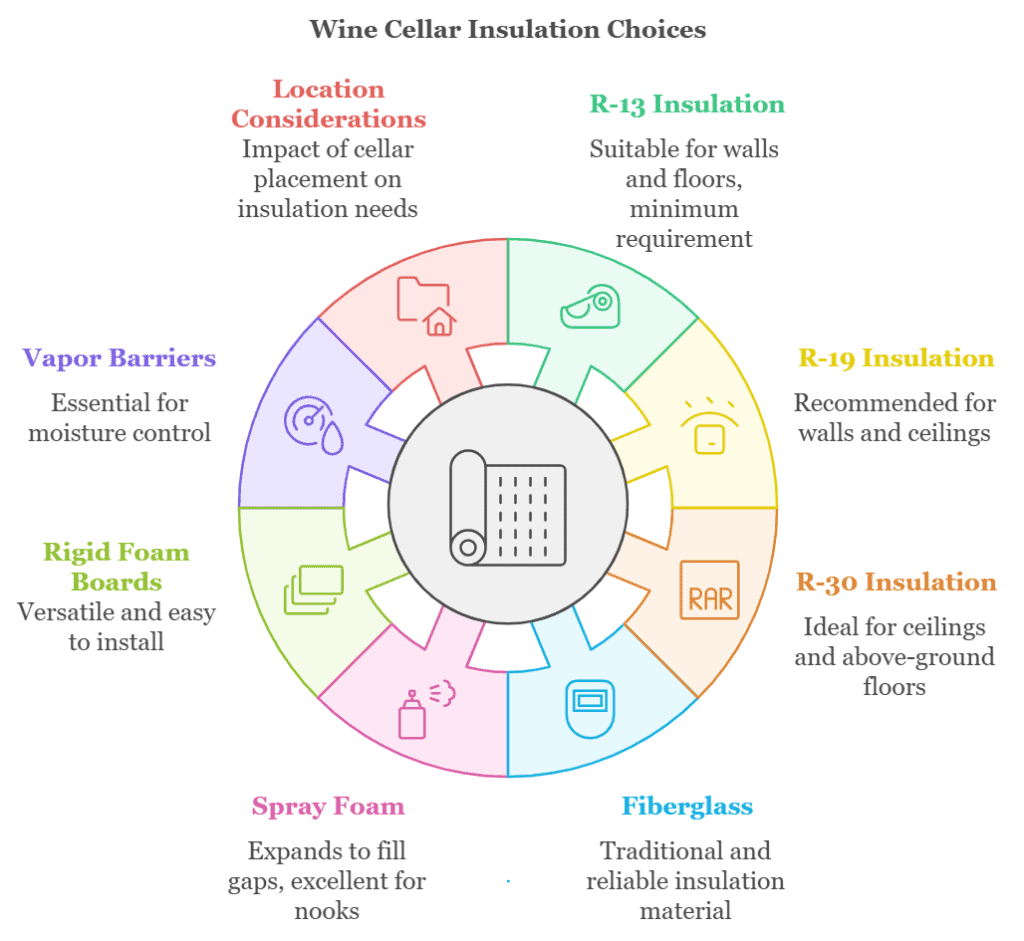
Top Insulation Materials for Wine Cellars in 2024
Insulation materials come a long way since I built my first wine cellar! Let me break down the top contenders for 2024.
Spray Foam
First up, spray foam – the superhero of insulation. This stuff expands to fill every nook and cranny, creating an airtight seal tighter than my uncle’s grip on the last bottle of Merlot at Thanksgiving. Pros? Incredible R-value and air sealing. Cons? It can be pricey, and you might need a pro to apply it. But for a top-notch cellar, it’s worth it.

Rigid Foam Boards
Next, rigid foam boards are the Swiss Army knife of insulation. They’re versatile, effective, and easy to work with. I’ve used them in basements and above-ground cellars with great results.
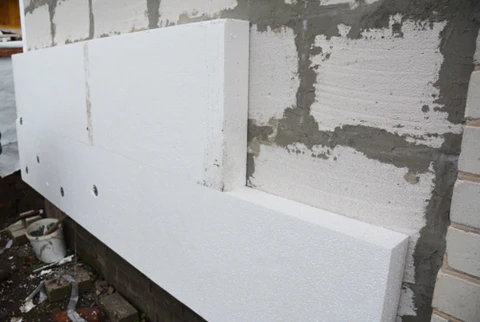
Pro tip: Combine them with spray foam for those hard-to-reach spots.
Fiberglass Batts
Don’t overlook fiberglass batts. Modern versions resist moisture and mold way better than your grandpa’s batts. Plus, they’re budget-friendly, leaving more cash for what really matters – the wine!

Cork Insulation
Now, here’s where things get exciting – eco-friendly options. Cork insulation? Yep, it’s a thing, and it’s fantastic. There’s even insulation made from recycled denim. Imagine your old jeans keeping your Chardonnay chilly!
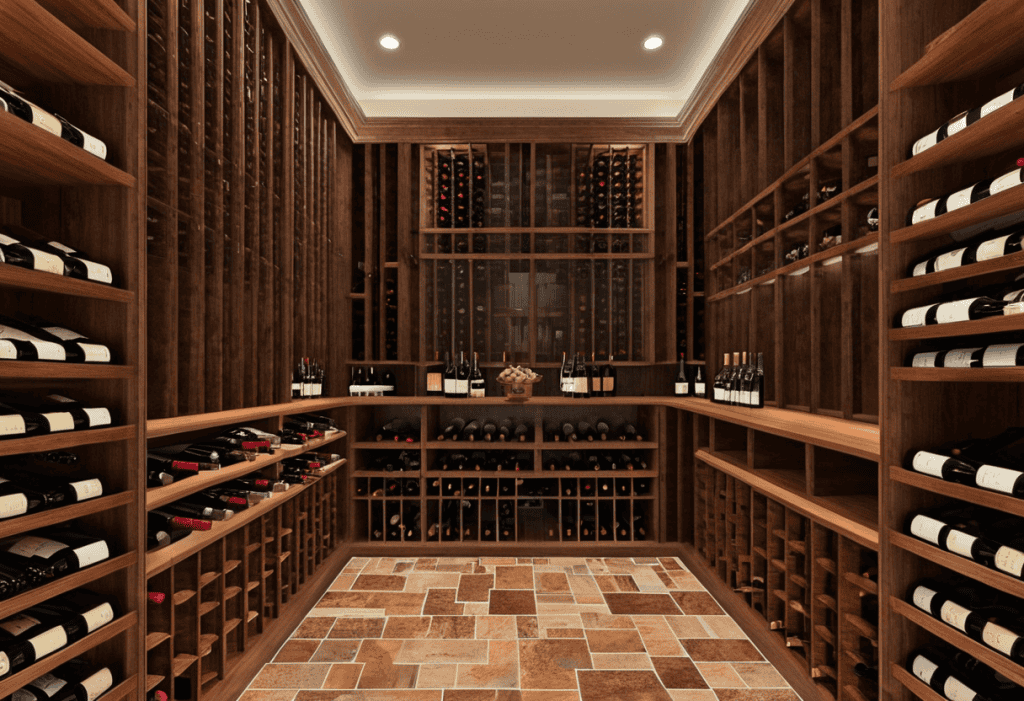
Whatever you choose in 2024, make sure it’s up to the task of protecting your liquid investments. There’s nothing worse than opening a prized bottle only to find it’s turned into fancy vinegar. Cheers to perfect insulation and even better wine!
Step-by-Step Guide to Insulating Your Wine Cellar
Alright, wine lovers, let’s roll up our sleeves and dive into insulating your wine cellar! Trust me, after my DIY disasters, I’ve learned a thing or two about doing this right.
Assess your space – 1. Step
First things first: assess your space. Is your cellar a cool basement corner or a converted closet? Each space has its own quirks. I once tried to insulate a sun-drenched spare room – big mistake! Take a good look at your walls, floor, and ceiling. Any damp spots? Drafts? Make a note of everything.
Clear out your space – 2. Step
Now, it’s prep time! This is crucial, folks. Clear out your space completely. Yes, that means all your wine bottles, too (perfect excuse for a tasting party, right?). Check for any existing insulation – you might be surprised what’s hiding behind those walls. I once found newspaper from the 1950s! Not exactly top-notch insulation material.
Installation – 3. Step
When it comes to installation, technique is key. For fiberglass batts, wear gloves and a mask – trust me, that itchy stuff is no joke. If you’re using spray foam, consider calling in the pros. My first attempt looked like a foam monster exploded in my cellar!
Pro Tip
Pay extra attention to corners and joints. These are prime spots for thermal bridges – sneaky heat pathways that can wreak havoc on your cellar’s temp. Use caulk or foam to seal any gaps you find. It’s like playing wine cellar detective!
Remember, a well-insulated cellar is a happy cellar. Take your time, do it right, and your wines will thank you for years to come. Cheers to cozy, perfectly chilled bottles!
Advanced Insulation Techniques for Optimal Wine Storage
Alright, wine enthusiasts, let’s level up your cellar game! After my fair share of trial and error, I’ve learned that advanced insulation is where the magic happens.
Thermal Envelopes
First up, let’s talk thermal envelopes. Think of it as a cozy sleeping bag for your entire cellar. I once thought just insulating the walls was enough – boy, was I wrong! A proper thermal envelope wraps your cellar in a continuous layer of insulation from floor to ceiling. It’s like giving your wines a big, temperature-controlled hug.
Doors & Windows
Don’t forget about doors and windows – they’re sneaky culprits for temperature fluctuations. I learned this the hard way when I found my prized Cabernet cooking next to a poorly sealed door. Weatherstripping and insulated curtains can work wonders here. For extra credit, consider a vestibule or airlock entry. It’s like a bouncer for temperature changes!
Floor Insulation
Floor insulation is often overlooked, but it’s crucial. For my basement cellar, I laid down rigid foam boards before the flooring. In my buddy’s above-ground cellar, we used spray foam between the joists. The result? Consistently cool temps from top to bottom.
Ventilation
Here’s the kicker – ventilation. I know it sounds counterintuitive when we’re talking insulation. But trust me, a little airflow goes a long way in preventing mold and musty odors. A small exhaust fan or a passive ventilation system can work wonders. Just make sure it’s properly insulated, too!
Remember, these advanced techniques separate the good cellars from the great ones. Your wines deserve the best, so why not give it to them? Cheers to perfectly stored, age-worthy wines!
Common Mistakes to Avoid in Wine Cellar Insulation
Let me tell you, I’ve made every insulation mistake in the book. Here’s hoping you can learn from my blunders!
Underestimate R-value
First up, don’t underestimate the R-value you need. I once thought, “Hey, it’s cool in my basement. I don’t need much insulation.” Wrong! In my humid climate, I needed way more than I thought. Do your homework on what R-value your area requires. Trust me, your wines (and your energy bill) will thank you.
Vapor Barriers
Vapor barriers? I used to think they were optional. Big mistake! Skipping this step is like inviting moisture to a wine-ruining party. I learned the hard way when I found mold on some of my favorite bottles. Now, I never insulate without a proper vapor barrier. It’s a game-changer for moisture control.
Improper Installation
Here’s a doozy – improper installation. Ever tried to stuff too much insulation into a small space? I have, and let me tell you, compressed insulation is about as useful as a cork in a screw-top bottle. Take your time, cut pieces to fit properly, and avoid gaps like the plague. One tiny air leak can throw off your whole cellar’s temperature.
DIY – sometimes you need a Pro
Lastly, don’t be a hero. I thought I could DIY everything, but sometimes, you need a pro. A professional assessment can catch issues you might miss, like hidden moisture problems or structural quirks that affect insulation. Yeah, it costs more upfront, but it’s cheaper than replacing a ruined wine collection.
Remember, good insulation is an investment in your wine’s future. Avoid these mistakes, and you’ll be sipping perfectly aged vino for years.
Maintaining and Upgrading Your Wine Cellar Insulation
Let’s discuss keeping your cellar’s insulation in top shape. Trust me, a little TLC goes a long way!
Watch for Red Flags
First off, watch for red flags. Is your cooling system working overtime? Are there fluctuations in temperature or humidity? I once noticed condensation on my bottles – a sure sign my insulation was slacking. Don’t ignore these warning signs like I did!
Regular Check-ups
Regular check-ups are key. Every few months, I do a thorough inspection. I look for any cracks, gaps, or signs of moisture. Pro tip: use a thermal camera to spot cold spots. It’s like giving your cellar a high-tech health scan!
Upgrade
Now, when should you upgrade? Well, insulation doesn’t last forever. After about 15-20 years, or if you notice persistent issues, it might be time for a facelift. I recently switched from fiberglass to spray foam in my older cellar, and wow, what a difference!
Smart Tech
Here’s the cool part – smart tech! I’ve integrated sensors that monitor temperature, humidity, and even air quality. They send alerts to my phone if anything’s off. It’s like having a 24/7 wine guardian!
Remember, good maintenance keeps your insulation effective and your wines happy. A little effort now means better-tasting vino later. Cheers to that!
Pro Tip: To learn more about wine cellar insulation, covering materials, installation tips, and common mistakes to avoid, I recommend checking the following industry leader’s website: Breezaire USA
FAQ – Wine Cellar Insulation
1. What is the ideal temperature for a wine cellar?
Answer: The ideal temperature range for a wine cellar is typically between 55°F and 59°F (13°C to 15°C).
2. How important is humidity in a wine cellar?
Answer: Humidity is crucial; the ideal range is 50-70%. This prevents corks from drying out and maintains wine quality.
3. What is R-value and why does it matter for wine cellar insulation?
Answer: R-value measures insulation effectiveness. Higher R-values indicate better insulation, crucial for maintaining stable cellar temperatures.
4. Can I use regular household insulation for my wine cellar?
Answer: While possible, specialized wine cellar insulation often performs better due to its moisture-resistant properties and higher R-values.
5. What’s the difference between spray foam and rigid foam insulation?
Answer: Spray foam expands to fill gaps and cracks, while rigid foam comes in pre-cut boards. Spray foam typically offers better air sealing but is more expensive.
6. How often should I check my wine cellar’s insulation?
Answer: It’s recommended to inspect your cellar’s insulation at least twice a year, looking for signs of moisture, gaps, or degradation.
7. What are signs that my wine cellar insulation needs upgrading?
Answer: Fluctuating temperatures, increased energy bills, visible moisture, or mold growth are all signs that your insulation may need upgrading.
8. Is it necessary to hire a professional for wine cellar insulation?
Answer: While DIY is possible, professional installation ensures proper application and can identify potential issues you might miss.
9. How do vapor barriers work in wine cellar insulation?
Answer: Vapor barriers prevent moisture from penetrating the insulation, crucial for maintaining proper humidity levels and preventing mold growth.
10. Can I insulate an above-ground wine cellar effectively?
Answer: Yes, but it often requires more insulation and careful planning to combat external temperature fluctuations and sunlight exposure.
11. What are some eco-friendly insulation options for wine cellars?
Answer: Cork, recycled denim, and sheep’s wool are environmentally friendly options that can provide effective insulation for wine cellars.
12. How does proper insulation affect wine aging?
Answer: Proper insulation maintains stable temperature and humidity, allowing wines to age consistently and develop complex flavors over time.
13. What is a thermal bridge, and why is it important in wine cellar insulation?
Answer: Thermal bridges are areas where heat can transfer through the insulation barrier. Addressing these is crucial for maintaining consistent cellar temperatures.
14. How can smart technology improve wine cellar insulation?
Answer: Smart sensors can monitor temperature, humidity, and air quality, alerting you to any changes that might indicate insulation issues.
15. Is it possible to over-insulate a wine cellar?
Answer: While rare, over-insulation can lead to poor air circulation. Balancing insulation with proper ventilation is key for optimal wine storage conditions.
Conclusion
There you have it, fellow wine lovers! Proper wine cellar insulation is the unsung hero in preserving the quality and flavor of your cherished collection. By understanding the principles we’ve uncorked in this guide, you’re well on your way to creating the perfect sanctuary for your wines.
Remember, investing in quality insulation is investing in the future of your vintages. So, why wait? It’s time to raise a glass to perfectly insulated cellars and the exquisite wines they protect.
Cheers to your next perfectly aged bottle, safeguarded by your newly optimized wine cellar insulation!
For your reference, the latest articles by Didi Somm include:
- How to Store Opened Champagne: Get 5 Expert Tips to Keep It Sparkling
- What Does Champagne Taste Like? – 7 Expert Tips about Flavors and Styles
- Illuminate Your Vino: 5 Best Wine Cellar Lighting Ideas for the Perfect Ambiance
- Uncork Peace of Mind: The Ultimate Guide to Wine Collection Insurance (2024 Edition)
- How to Create a Home Wine Cellar for Beginners: 2024 Ultimate Guide
- The Ultimate Guide to Wine Cellar Climate Control in 2024: Preserve Your Collection Like a Pro
Important Notice: The information in this article is for general and public information purposes only. It solely reflects Didi Somm’s or his Staff’s opinion, and no responsibility can be assumed for errors or omissions in the service’s contents. For details, please check the Disclaimer at the bottom of the homepage.


